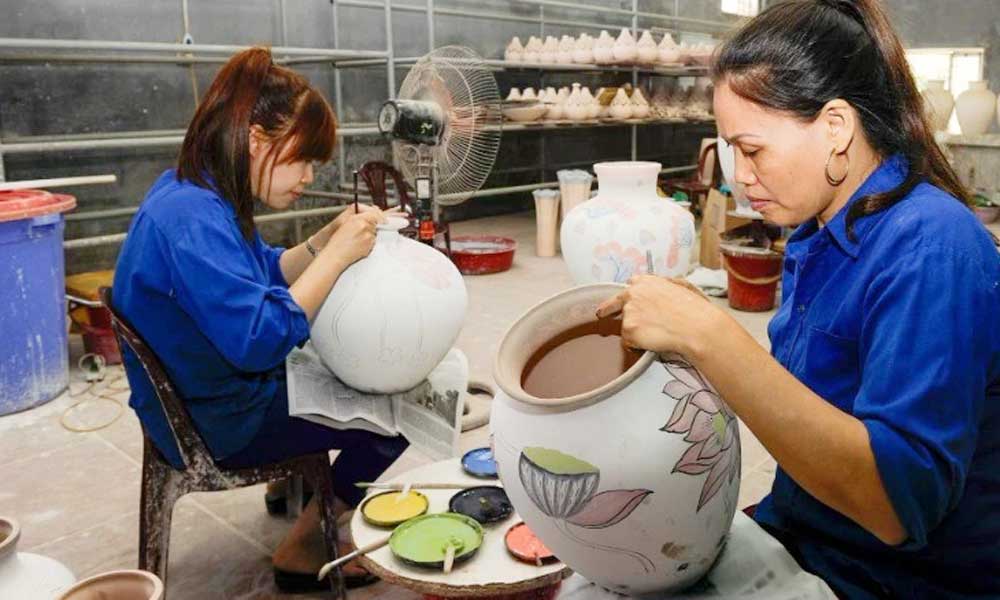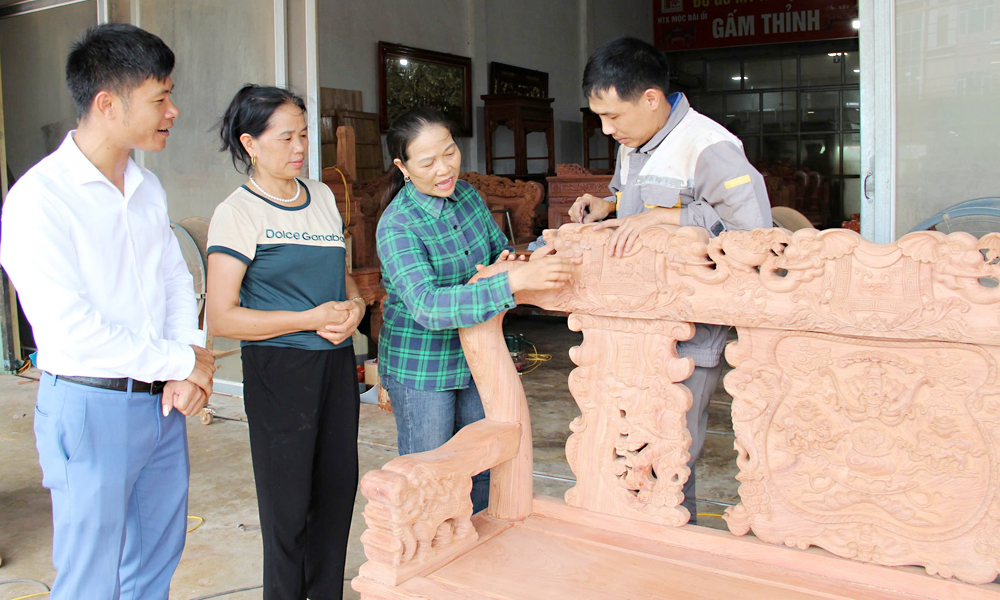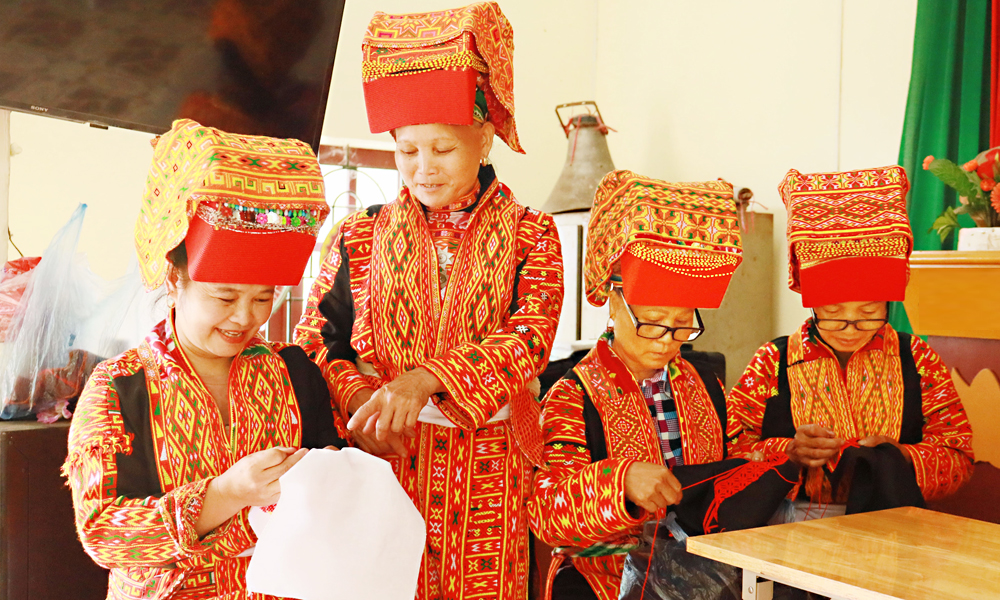Finding new directions for craft villages
Fragmented and dispersed production, with manufacturing facilities often located within households and residential areas, has led to increasingly serious pollution in craft villages. This not only affects the health of residents but also limits the development of craft village products. In response, numerous programmes and solutions have been implemented to support craft villages in "rescuing the environment" and moving towards sustainable development.
Technological innovation, environmental improvement
With the principle of “not trading the environment for economic growth”, many localities are striving to prevent and minimise pollution from craft villages.
 |
|
Painting patterns on ceramic products at Bat Trang Pottery Village. |
Various regions have introduced incentive mechanisms to support craft households in adopting new technologies, gradually changing their production mindset and investing in modern machinery to improve manufacturing efficiency.
More importantly, the application of science and technology helps shorten manual stages, thereby easing labour intensity and enhancing the environmental conditions in craft villages.
A notable example is Bat Trang Pottery Village (Gia Lam, Ha Noi). In the past, the village consumed around 800 tonnes of coal daily, releasing harmful gases into the environment, such as CO, SO₂, H₂S, silica dust, and solid waste.
To pursue sustainable development, Bat Trang’s businesses and production facilities have actively switched from traditional coal and gas kilns to modern gas-fired kilns.
To date, nearly 1,000 households in Bat Trang (over 90%) have adopted liquefied gas-fired ceramic kilns, significantly reducing waste products compared to coal kilns and limiting pollution in the surrounding environment, while also conserving energy.
Investing in modern technology has also helped lower product costs by 15–30%; production accuracy now exceeds 85%; the rate of defective or damaged products has dropped considerably, and the diversity of product designs has increased.
These are competitive advantages that boost the production capacity and market competitiveness of Bat Trang pottery.
Similarly, through “greening” efforts, several rattan and bamboo enterprises in Phu Vinh Craft Village, Phu Nghia Commune, Chuong My District (Ha Noi), have gained both economic and environmental benefits.
Before implementing cleaner production, businesses lost up to 10% of fresh rattan during the boiling, treatment, and procurement stages. Since adopting cleaner production methods, raw material loss has been drastically reduced, operating costs have dropped, and environmental emissions have been curtailed.
The Thuy Ung buffalo horn comb craft village in Hoa Binh Commune, Thuong Tin District (Ha Noi), has over 200 handicraft production establishments embedded within residential areas, yet environmental pollution has been visibly improved.
According to local officials, relevant authorities and the local government have taken proactive measures to educate and assist residents in addressing pollution issues.
Additionally, production facilities here have realised that sustainable manufacturing must go hand in hand with environmental protection. As a result, they have invested in modern machinery and equipment for both production and pollution control.
For instance, dust collection pits have been installed within workshops, and water filtration tanks have been built at raw material processing stages, including the preparation of buffalo and cow horn and hide, directly at households, thus helping to reduce wastewater pollution.
It is evident that the effort of craft villages to invest in technology, machinery, and transition towards green, clean, and energy-efficient production models has contributed to increasing consumer confidence in craft village products both domestically and internationally.
Developing craft villages towards sustainability
The continued existence of craft villages across the country demonstrates the enduring vitality of traditional handicrafts. However, despite positive signs, some traditional villages are facing the risk of decline or even total disappearance. One major cause of this is the shortage of production materials.
In addition to raw material issues, many craft villages face difficulties in capital, market access, and technology. Most still operate as household businesses, lacking links and cooperation, leading to low production efficiency. This makes it difficult for craft villages to access financing, technology, and markets, thereby hindering their development.
To promote the development of rural occupations and craft villages, the government and the prime minister have issued various support policies and mechanisms. On this basis, many localities have devised plans for development and preservation, with craft village tourism being widely promoted.
Experts suggest that a synchronous implementation of multiple solutions is necessary, starting with the development of craft village planning integrated with environmental protection. Planning should be based on the specific characteristics of each village. Small-scale, newly-formed, and scattered production villages should be relocated out of residential areas through centralised planning.
Meanwhile, long-established traditional villages with large-scale production need adjustments to improve working conditions, environmental hygiene, and limit the construction of multi-storey buildings to preserve their traditional character.
Local government management agencies should strengthen the inspection and assessment of environmental conditions in craft villages. Production projects must undergo environmental impact assessments before operation, and stronger inspections and closures should be applied to polluting facilities.
There should also be incentive mechanisms and support for villages to invest in technological innovation and adopt advanced equipment, prioritising solutions that minimise or eliminate environmental pollution.
 Bắc giang
Bắc giang













Reader's comments (0)